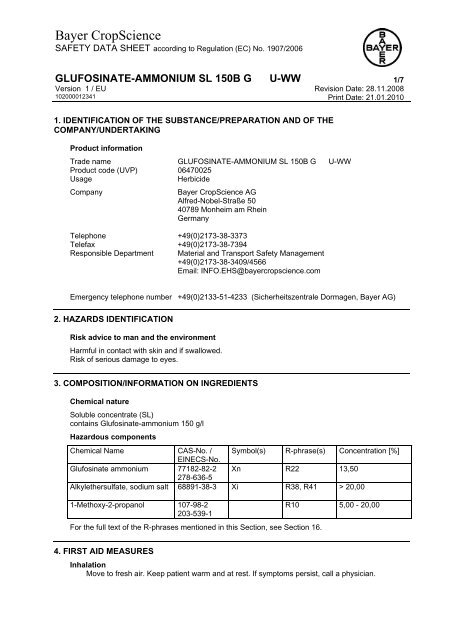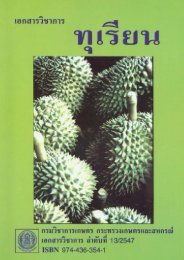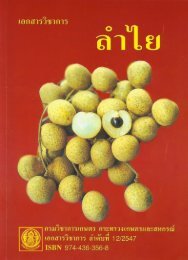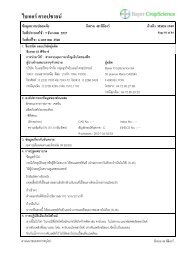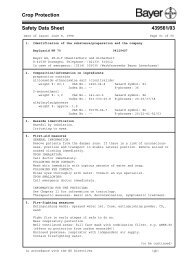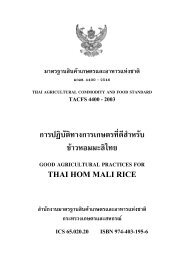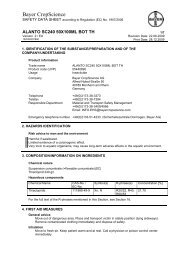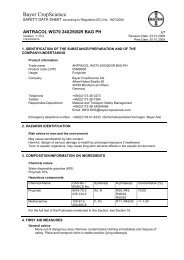Bayer Cropscience Co.,Ltd.
Bayer Cropscience Co.,Ltd.
Bayer Cropscience Co.,Ltd.
You also want an ePaper? Increase the reach of your titles
YUMPU automatically turns print PDFs into web optimized ePapers that Google loves.
<strong>Bayer</strong> CropScience<br />
SAFETY DATA SHEET according to Regulation (EC) No. 1907/2006<br />
GLUFOSINATE-AMMONIUM SL 150B G U-WW 1/7<br />
Version 1 / EU Revision Date: 28.11.2008<br />
102000012341 Print Date: 21.01.2010<br />
1. IDENTIFICATION OF THE SUBSTANCE/PREPARATION AND OF THE<br />
COMPANY/UNDERTAKING<br />
Product information<br />
Trade name GLUFOSINATE-AMMONIUM SL 150B G U-WW<br />
Product code (UVP) 06470025<br />
Usage<br />
Herbicide<br />
<strong>Co</strong>mpany<br />
<strong>Bayer</strong> CropScience AG<br />
Alfred-Nobel-Straße 50<br />
40789 Monheim am Rhein<br />
Germany<br />
Telephone +49(0)2173-38-3373<br />
Telefax +49(0)2173-38-7394<br />
Responsible Department Material and Transport Safety Management<br />
+49(0)2173-38-3409/4566<br />
Email: INFO.EHS@bayercropscience.com<br />
Emergency telephone number +49(0)2133-51-4233 (Sicherheitszentrale Dormagen, <strong>Bayer</strong> AG)<br />
2. HAZARDS IDENTIFICATION<br />
Risk advice to man and the environment<br />
Harmful in contact with skin and if swallowed.<br />
Risk of serious damage to eyes.<br />
3. COMPOSITION/INFORMATION ON INGREDIENTS<br />
Chemical nature<br />
Soluble concentrate (SL)<br />
contains Glufosinate-ammonium 150 g/l<br />
Hazardous components<br />
Chemical Name CAS-No. / Symbol(s) R-phrase(s) <strong>Co</strong>ncentration [%]<br />
EINECS-No.<br />
Glufosinate ammonium 77182-82-2 Xn R22 13,50<br />
278-636-5<br />
Alkylethersulfate, sodium salt 68891-38-3 Xi R38, R41 > 20,00<br />
1-Methoxy-2-propanol 107-98-2<br />
203-539-1<br />
For the full text of the R-phrases mentioned in this Section, see Section 16.<br />
R10 5,00 - 20,00<br />
4. FIRST AID MEASURES<br />
Inhalation<br />
Move to fresh air. Keep patient warm and at rest. If symptoms persist, call a physician.
<strong>Bayer</strong> CropScience<br />
SAFETY DATA SHEET according to Regulation (EC) No. 1907/2006<br />
GLUFOSINATE-AMMONIUM SL 150B G U-WW 2/7<br />
Version 1 / EU Revision Date: 28.11.2008<br />
102000012341 Print Date: 21.01.2010<br />
Skin contact<br />
Wash off immediately with soap and plenty of water. Get medical attention if irritation<br />
develops and persists.<br />
Eye contact<br />
Hold eye open and rinse slowly and gently with water for 15-20 minutes. Remove contact<br />
lenses, if present, after the first 5 minutes, then continue rinsing eye. Get medical attention if<br />
irritation develops and persists.<br />
Ingestion<br />
Rinse mouth. Do NOT induce vomiting. Keep patient warm and at rest. Call a physician or<br />
poison control center immediately.<br />
Notes to Physician<br />
Symptoms<br />
hyperthermia, dyspnoea, Gastrointestinal discomfort, Tachycardia, Respiratory disorder,<br />
spasm, Daze, Symptoms may be delayed.<br />
Risks<br />
Watch victim for at least 48 hours because of possible delayed signs of poisoning.<br />
Treatment<br />
Initial treatment: symptomatic.<br />
Forced alkaline diuresis and hemodialysis may be considered.<br />
Monitor: respiratory, cardiac and central nervous system.<br />
EEG - monitoring (Electroencephalogram).<br />
Monitor: fluid balance.<br />
Therapeutical: Phenobarbital-Sodium, 1 mg/kg intra-muscular or subcutaneously till<br />
maximum 5 mg/kg daily; when necessary, 10 mg Diazepam slowly intravenously.<br />
There is no specific antidote.<br />
<strong>Co</strong>ntraindication: atropine.<br />
Recovery is spontaneous and without sequelae.<br />
Give oxygen or artificial respiration if needed.<br />
Keep respiratory tract clear.<br />
Gastric lavage should be considered in cases of significant ingestions within the first 2 hours.<br />
However, the application of activated charcoal and sodium sulphate is always advisable.<br />
Symptoms of poisoning may only appear several hours later.<br />
Keep under medical supervision for at least 48 hours.<br />
5. FIRE-FIGHTING MEASURES<br />
Suitable Extinguishing Media<br />
Water spray<br />
Foam<br />
Carbon dioxide (CO2)<br />
Dry powder<br />
Extinguishing media which should not be used for safety reasons<br />
High volume water jet<br />
Specific hazards during fire fighting<br />
In the event of fire the following may be released:<br />
Carbon monoxide (CO)<br />
Nitrogen oxides (NOx)<br />
Oxides of phosphorus<br />
Sulphur oxides<br />
Special protective equipment for fire-fighters
<strong>Bayer</strong> CropScience<br />
SAFETY DATA SHEET according to Regulation (EC) No. 1907/2006<br />
GLUFOSINATE-AMMONIUM SL 150B G U-WW 3/7<br />
Version 1 / EU Revision Date: 28.11.2008<br />
102000012341 Print Date: 21.01.2010<br />
In the event of fire, wear self-contained breathing apparatus.<br />
Further information<br />
Remove product from areas of fire, or otherwise cool containers with water in order to avoid<br />
pressure being built up due to heat.<br />
Whenever possible, contain fire-fighting water by diking area with sand or earth.<br />
Do not allow run-off from fire fighting to enter drains or water courses.<br />
6. ACCIDENTAL RELEASE MEASURES<br />
Personal Precautions<br />
Use personal protective equipment.<br />
Remove all sources of ignition.<br />
Environmental Precautions<br />
Do not allow to get into surface water, drains and ground water.<br />
Methods for cleaning up<br />
Keep in suitable, closed containers for disposal.<br />
Soak up with inert absorbent material (e.g. sand, silica gel, acid binder, universal binder).<br />
Additional Advice<br />
Information regarding safe handling, see section 7.<br />
Information regarding personal protective equipment, see section 8.<br />
Information regarding waste disposal, see section 13.<br />
7. HANDLING AND STORAGE<br />
Handling<br />
Advice on safe handling<br />
Provide for appropriate exhaust ventilation and dust collection at machinery.<br />
Storage<br />
Requirements for storage areas and containers<br />
Store in original container.<br />
Keep containers tightly closed in a dry, cool and well-ventilated place.<br />
Keep away from direct sunlight.<br />
Protect from freezing.<br />
Advice on common storage<br />
Keep away from food, drink and animal feedingstuffs.<br />
Temperature tolerance 0 °C to 40 °C<br />
Suitable materials<br />
<strong>Co</strong>extruded containers with an internal barrier layer made of ethylene vinyl alcohol<br />
copolymer (EVOH)<br />
<strong>Co</strong>extruded containers with an internal barrier layer made of polyamide (PA)<br />
HDPE (high density polyethylene)<br />
8. EXPOSURE CONTROLS/PERSONAL PROTECTION<br />
<strong>Co</strong>mponents with workplace control parameters
<strong>Bayer</strong> CropScience<br />
SAFETY DATA SHEET according to Regulation (EC) No. 1907/2006<br />
GLUFOSINATE-AMMONIUM SL 150B G U-WW 4/7<br />
Version 1 / EU Revision Date: 28.11.2008<br />
102000012341 Print Date: 21.01.2010<br />
<strong>Co</strong>mponents CAS-No. <strong>Co</strong>ntrol parameters Update Basis<br />
1-Methoxy-2-propanol 107-98-2 375 mg/m3 / 100 ppm 02 2006 EU ELV<br />
(TWA)<br />
1-Methoxy-2-propanol 107-98-2 568 mg/m3 / 150 ppm<br />
(STEL)<br />
02 2006 EU ELV<br />
Personal protective equipment<br />
In normal use and handling conditions please refer to the label and/or leaflet. In all other cases<br />
the following recommendations would apply.<br />
Respiratory Protection<br />
No personal respiratory protective equipment normally required.<br />
Respiratory protection should only be used to control residual risk of<br />
short duration activities, when all reasonably practicable steps have<br />
been taken to reduce exposure at source e.g. containment and/or<br />
local extract ventilation. Always follow respirator manufacturer's<br />
instructions regarding wearing and maintenance.<br />
Hand protection<br />
Eye protection<br />
Skin and body protection<br />
Wear CE Marked (or equivalent) nitrile rubber gloves (minimum<br />
thickness 0,40 mm). Wash when contaminated. Dispose of when<br />
contaminated inside, when perforated or when contamination<br />
outside cannot be removed. Wash hands always before eating,<br />
drinking, smoking or using the toilet.<br />
Wear goggles conforming to EN166 (Field of Use 5 or equivalent).<br />
Wear standard coverall and type 6 suit.<br />
Wear two layers of clothing wherever possible. Polyester/cotton or<br />
cotton overalls should be worn under chemical protection suit and<br />
should be professionally laundered frequently.<br />
Hygiene measures<br />
Remove soiled clothing immediately and clean thoroughly before using again.<br />
Keep working clothes separately.<br />
Wash hands thoroughly with soap and water after handling and before eating, drinking,<br />
chewing gum, using tobacco, using the toilet or applying cosmetics.<br />
When using, do not eat, drink or smoke.<br />
Protective measures<br />
Avoid contact with skin and eyes.<br />
9. PHYSICAL AND CHEMICAL PROPERTIES<br />
Appearance<br />
Form<br />
<strong>Co</strong>lour<br />
Odour<br />
Safety data<br />
pH<br />
Boiling point/boiling range<br />
liquid<br />
blue to blue green<br />
weakly pungent<br />
6,8 - 7,8 at 100 % (23 °C)<br />
approx. 99 °C at 1.013 hPa<br />
Test conducted with a similar formulation.
<strong>Bayer</strong> CropScience<br />
SAFETY DATA SHEET according to Regulation (EC) No. 1907/2006<br />
GLUFOSINATE-AMMONIUM SL 150B G U-WW 5/7<br />
Version 1 / EU Revision Date: 28.11.2008<br />
102000012341 Print Date: 21.01.2010<br />
Flash point approx. 57 °C<br />
The product does not sustain combustion.<br />
Autoignition Temperature approx. 405 °C<br />
Density approx. 1,11 g/cm³ at 20 °C<br />
Surface tension approx. 29 mN/m at 40 °C<br />
Impact Sensitivity<br />
Explosivity<br />
not impact-sensitive<br />
Not explosive.<br />
92/69/EEC, A.14 / OECD 113<br />
10. STABILITY AND REACTIVITY<br />
Hazardous Decomposition<br />
Products<br />
Thermal decomposition<br />
Ammonia<br />
> 200 °C , Heating rate: 10 K/min<br />
Test conducted with a similar formulation.<br />
Hazardous Reactions<br />
Stable under recommended storage conditions.<br />
11. TOXICOLOGICAL INFORMATION<br />
Acute Oral Toxicity<br />
LD50 (rat) 1.730 mg/kg<br />
Acute Inhalation Toxicity<br />
Acute Dermal Toxicity<br />
Skin Irritation<br />
Eye Irritation<br />
Sensitization<br />
LC50 (rat) 2,97 mg/l<br />
Exposure time: 4 h<br />
Determined in the form of a respirable aerosol.<br />
During intended and foreseen applications, no respirable aerosol is<br />
formed.<br />
LD50 (rat) 593 mg/kg<br />
Slight irritant effect - does not require labelling. (rabbit)<br />
Severe eye irritation. (rabbit)<br />
Non-sensitizing. (guinea pig)<br />
OECD Test Guideline 406, Buehler test<br />
Further information<br />
Information given is based on data obtained from similar substances.<br />
12. ECOLOGICAL INFORMATION<br />
Elimination information (persistence and degradability)<br />
Biodegradability<br />
The single components are biologically degradable.
<strong>Bayer</strong> CropScience<br />
SAFETY DATA SHEET according to Regulation (EC) No. 1907/2006<br />
GLUFOSINATE-AMMONIUM SL 150B G U-WW 6/7<br />
Version 1 / EU Revision Date: 28.11.2008<br />
102000012341 Print Date: 21.01.2010<br />
Ecotoxicity effects<br />
Toxicity to Fish<br />
Toxicity to daphnia<br />
Toxicity to algae<br />
Toxicity to bacteria<br />
LC50 (Oncorhynchus mykiss (rainbow trout)) 13,4 mg/l<br />
Exposure time: 96 h<br />
Test conducted with a similar formulation.<br />
EC50 (Water flea (Daphnia magna)) 17,8 mg/l<br />
Exposure time: 48 h<br />
Test conducted with a similar formulation.<br />
EC50 (Pseudokirchneriella subcapitata) 71,3 mg/l<br />
Exposure time: 72 h<br />
Test conducted with a similar formulation.<br />
EC50 (Activated sludge) > 1.000 mg/l<br />
Exposure time: 3 h<br />
The value mentioned relates to the active ingredient glufosinateammonium.<br />
13. DISPOSAL CONSIDERATIONS<br />
Product<br />
Do not dispose of waste into sewer.<br />
In accordance with current regulations and, if necessary, after consultation with the site<br />
operator and/or with the responsible authority, the product may be taken to a waste disposal<br />
site or incineration plant.<br />
<strong>Co</strong>ntaminated packaging<br />
Triple rinse containers.<br />
Rinsed packaging may be acceptable for landfill, otherwise incineration will be required in<br />
accordance with local regulations.<br />
Not completely emptied packagings should be disposed of as hazardous waste.<br />
Do not use containers for other products.<br />
Waste key for the unused product<br />
020108 agrochemical waste containing dangerous substances<br />
14. TRANSPORT INFORMATION<br />
ADR/RID/ADNR<br />
UN-Number 2902<br />
Labels 6.1<br />
Packaging group<br />
III<br />
Hazard no. 60<br />
Description of the goods<br />
IMDG<br />
UN-Number 2902<br />
Labels 6.1<br />
Packaging group<br />
III<br />
EmS<br />
Description of the goods<br />
PESTICIDE, LIQUID, TOXIC, N.O.S.<br />
(GLUFOSINATE-AMMONIUM SOLUTION)<br />
F-A , S-A<br />
PESTICIDE, LIQUID, TOXIC, N.O.S.<br />
(GLUFOSINATE-AMMONIUM SOLUTION)
<strong>Bayer</strong> CropScience<br />
SAFETY DATA SHEET according to Regulation (EC) No. 1907/2006<br />
GLUFOSINATE-AMMONIUM SL 150B G U-WW 7/7<br />
Version 1 / EU Revision Date: 28.11.2008<br />
102000012341 Print Date: 21.01.2010<br />
IATA<br />
UN-Number 2902<br />
Labels 6.1<br />
Packaging group<br />
Description of the goods<br />
III<br />
PESTICIDE, LIQUID, TOXIC, N.O.S.<br />
(GLUFOSINATE-AMMONIUM SOLUTION )<br />
15. REGULATORY INFORMATION<br />
Classification and labelling in accordance with the EC Directive on dangerous<br />
preparations 1999/45/EC as amended.<br />
Classification:<br />
Hazard warning labelling compulsory<br />
Hazardous components which must be listed on the label:<br />
• Glufosinate ammonium<br />
Symbol(s)<br />
Xn<br />
Harmful<br />
R-phrase(s)<br />
R21/22 Harmful in contact with skin and if swallowed.<br />
R41<br />
Risk of serious damage to eyes.<br />
S-phrase(s)<br />
S36/37/39<br />
Wear suitable protective clothing, gloves and eye/face protection.<br />
Exceptional labelling<br />
To avoid risks to man and the environment, comply with the instructions for use.<br />
Further information<br />
WHO-classification: II (Moderately hazardous)<br />
16. OTHER INFORMATION<br />
Further information<br />
Text of R-phrases mentioned in Section 3<br />
R10<br />
Flammable.<br />
R22<br />
Harmful if swallowed.<br />
R38<br />
Irritating to skin.<br />
R41<br />
Risk of serious damage to eyes.<br />
The information given in this Data Sheet has been included in accordance with the guidelines<br />
established by Regulation (EC) 1907/2006. This data sheet complements the user's instructions,<br />
but does not replace them. The information it contains is based on the knowledge available about<br />
the product concerned at the time it was compiled. Users are further reminded of the possible<br />
risks of using a product for purposes other than those for which it was intended. The required<br />
information complies with current EEC legislation. Addressees are requested to observe any<br />
additional national requirements.<br />
Changes since the last version are highlighted in the margin. This version replaces all previous<br />
versions.


